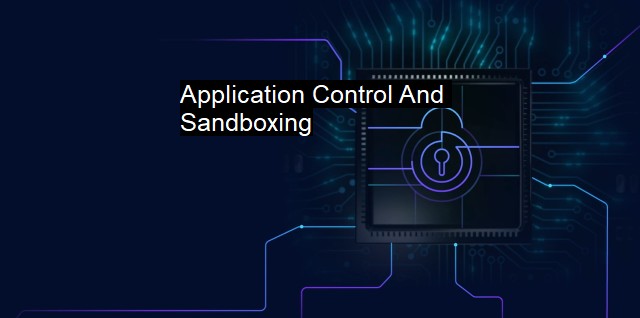What is Application Control And Sandboxing?
Strengthening Cybersecurity with Application Control and Sandboxing: A Comprehensive Guide to Protecting Endpoints From Complex Cyber Threats
Application control and sandboxing are crucial cybersecurity components that help to mitigate threats and reinforce the effectiveness of defensive measures. To better comprehend these elements, highlighting what they entail becomes indispensable.Application control is a form of security practice that restricts the systems' programs from executing functions that could potentially harm a computer, network, or IT ecosystem. It blocks unauthorized applications from accessing system processes, making them a bulwark against sophisticated cyber-attacks that can exploit vulnerabilities present in the system.
Integrated into a myriad of antivirus programs and cyber defense tools, this type of security provision makes use of whitelist and blacklist methodologies. Whitelisting involves the setting of permissions for authorized applications, thereby allowing only validated and trusted programs to run within the system. On the other hand, blacklisting entails blocking out specific applications that are known to be malicious or untrusted. Application control is pivotal, especially in environments that operate highly-sensitive data or systems vulnerable to sophisticated malware and bad actors.
Application control's pivotal role does not negate auxiliary strategies for robust defensive mechanisms. Sandboxing is one such essential accessory strategy in cybersecurity. A sandbox is an isolated, safe environment that separately evaluates or tests unknown, suspicious applications or programs without risking the safety of the entire system. Sandboxing provides a protective shield, which enables potentially harmful applications to run in a vacuum or ‘host’ that mirrors the actual operating system but is, in reality, a decoy and not the ‘actual’ host per se. The objectives include gauging the app’s functionality and determining if it includes malicious software.
Analogically put, sandboxing is akin to an evaluation or test mechanism that unravels modules, explores their components, and attempts possible combinations to test the software's functionality and attribute evaluation. It parallels a scientist’s endeavor of conducting a path-breaking experiment in systematically controlled conditions that segregate it from creating potential catastrophe in the real world.
In practice, sandboxing techniques can foresee possible threats by placing the received data or software into its isolated environments, mimicking the operation system. In this contained ambience, cybersecurity professionals scrutinize the behaviors of the program, analyse the intentions if suspect, all the while ensuring the main computer systems are not compromised or brought under threat.
In combination, these two cybersecurity practices offer comprehensive protection against a broad range of potential threats. Application control prevents unauthorized or malicious programs from accessing system processes, while sandboxing keeps malware isolated and contained, preventing it from spreading and causing widespread damage.
Nonetheless, the cybersecurity sphere also recognizes that both strategies savour their nuances. Application control can decimate the user's productivity if it's too restrictive, or security can be jeopardized if it's too loose, while sandboxing can be bypassed with sophisticated malware enabled with sandbox-detection technology. Thus, the trick lays in their judicious exploitation to maximize their cybersecurity rewards.
By combining and symbiotically using application control and sandboxing with traditional antivirus programs, cybersecurity defenses can be enhanced multifoldly, shielding systems and networks against various forms of malware, zero-day threats, Advanced Persistent Threats (APTs), and attacks targeting vulnerabilities in the system.
Application control and sandboxing are more relevant now than ever in the world of growing cyber threats. Enterprises and individuals must deploy both these strategies, adjusting them according to unique needs and scenarios. Further, cultivating a culture that understands cyber hygiene and security best-practices will imbue these technical control systems with depth and intrinsic value, thereby, creating an indomitable shield against the never-ending barrage of cyber threats.

Application Control And Sandboxing FAQs
What is application control?
Application control is a security feature that restricts the types of programs that can run on a system. It allows administrators to define an approved list of applications that can be installed and executed, while blocking all other programs.What is sandboxing in cybersecurity?
Sandboxing is a security technique that isolates an application or process from the rest of the system. It creates a virtual environment where the application can run safely, without affecting other applications or the underlying operating system. This technique is often used for testing and analyzing potentially malicious code.How does application control help prevent malware attacks?
Application control helps prevent malware attacks by restricting the execution of unauthorized programs. By limiting the types of applications that can run on a system, it reduces the attack surface for hackers and makes it harder for them to exploit vulnerabilities. It also helps prevent users from inadvertently installing or running malware-infected software.What are some benefits of using sandboxing in antivirus software?
Some benefits of using sandboxing in antivirus software include improved detection and prevention of malware, faster analysis and response to new threats, and reduced risk of false positives. Sandboxing allows antivirus programs to safely execute and analyze potentially malicious files without risking damage to the system. This helps identify and block new and emerging threats more quickly and efficiently than traditional signature-based detection methods.| | A | | | B | | | C | | | D | | | E | | | F | | | G | | | H | | | I | | | J | | | K | | | L | | | M | |
| | N | | | O | | | P | | | Q | | | R | | | S | | | T | | | U | | | V | | | W | | | X | | | Y | | | Z | |
| | 1 | | | 2 | | | 3 | | | 4 | | | 7 | | | 8 | | |||||||